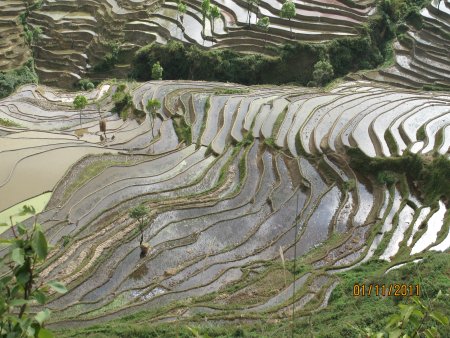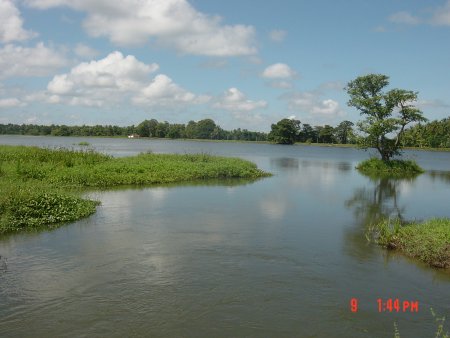Safeguarding wetlands in Globally Important Agricultural Heritage Systems

The great diversity of agriculture systems and wetlands around the world includes an agricultural heritage of global importance. Whether they are man-made, natural, or the combined works of nature and people, wetland agricultural heritage systems are managed by communities living in and around them, seeking to maintain their livelihoods and viable resource management. These areas are a legacy from the past, but they are also living and evolving systems, with ecological, social and cultural values.
Awareness of the importance of wise use of wetlands came to prominence at global level more than four decades ago. More recently, in 2015, FAO revolutionised its approach to technical development cooperation when more than a decade of piloting dynamic conservation of Globally Important Agricultural Heritage Systems (GIAHS) became a flagship programme. But what do wetlands and agricultural heritage have in common, and why is the GIAHS designation so important?
Agricultural Heritage Systems encompass farming, fishery, forestry and livestock systems and associated management practices. They represent humankind’s adaptation to sometimes extreme ecological conditions, ways of living in harmony with nature and conserving biodiversity, alongside evolving knowledge and culture. Each is unique in its own context.
Many types of wetlands constitute extraordinary landscapes with both ecological and cultural functions, and heritage values of global significance. Some wetland areas are indeed already recognized as Globally Important Agricultural Heritage Systems by FAO.
Examples include the Hani Rice Terraces of China and the Kuttanad Wetland Ecosystem in India. The ecosystem functions and services to people in these areas are of great economic, social and ecological value. There are important habitats supporting biological diversity, where distinctive land and water management techniques illustrate the culture and the unique harmony between people and their environment. They are also places for social interaction among members of the community.

Other examples include the Ancient Tank System of Sri Lanka (not yet a listed GIAHS), where a traditional integrated system of irrigation tanks andpaddy field management plays a significant role in the cultural and socio-economic aspects of the area. The tank system not only helps to maintain the cultivation of the staple food (rice), but also features in the community’s rituals and ceremonies that have been passed down from their ancestors. These rituals are repeated in each crop cycle, and they bring the entire community together.
Agricultural heritage and wetland conservation both have a combination of socio-cultural and environmental dimensions. Wetland ecosystems can often sustain both a rich biological diversity and high productivity of food and nutrition for human populations. The ecological and cultural values of wetland agricultural systems are an essential heritage for future generations.
With modernity bringing technological change everywhere in the world, however, new social values and economic transformations are developing all the time. Wetlands, and wetland agricultural areas in particular, are often affected by these transformations in ways that jeopardise their sustainability. It may be difficult to prevent exploitation, but it is important to respond in ways that go beyond mere listing of sites, and to safeguard and monitor the sustainability of the areas concerned, while helping the communities associated with them to achieve their rightful well-being, social prosperity and cultural integrity. Community well-being and local economies need to be at the forefront of conservation efforts if we want to enable people to respond to challenges of the age, and to ensure that the most culturally and ecologically important areas of the world continue to sustain their multiple values and services. Designating important agricultural systems and wetlands as GIAHS and Ramsar Sites is one key measure, that has enormous potential to contribute to the achievement of biodiversityconservation and the Sustainable Development Goals.
By Professor Stefano Grego (Chairman of the Scientific Committee, World Agricultural Heritage Foundation)
Professor Stefano Grego graduated in Agriculture from the University of Perugia in November 1968 with maximum cum laude. In October 1969, he won a permanent position as researcher at the National Research Council of Italy (CNR). He has been a Full Professor in Agricultural Chemistry at the Faculty of Agriculture of University of Tuscia in Viterbo, where he has been Vice Rector for 10 years. Prof Grego is currently Chairman of the Scientific Committee of the World Agricultural Heritage Foundation (WAHF). He has long experience of cooperation in many countries in Africa, Asia and South America. He has been a visiting professor in many European and North American Universities, and has been awarded five Honoris Causa degrees.
By Dr. Parviz Koohafkhan (Founder and President of the World Agricultural Heritage Foundation)
Dr. Koohafkan conceptualized and launched on behalf of FAO, the UN Partnership Initiative on “Conservation and Adaptive Management of Globally Important Agricultural Heritage Systems (GIAHS)” during the World Summit on Sustainable Development in Johannesburg South Africa (WSSD, 2002) and promoted the recognition by FAO, and dynamic conservation of Globally Important Agricultural Heritage Systems (GIAHS) in many countries around the world. He is currently Senior Advisor in Food and Agriculture Organization of the United Nations and Honorary Senior Research Fellow at Bioversity International (formerly IPGRI) in Rome, Italy, and the Research Institute for Humanity and Nature (RIHN) in Kyoto, Japan.
He has an Engineering degree in Agronomy and Natural Resources Management from University of Teheran, Iran and a Masters degree and Ph.D. in Applied Ecology from the University of Sciences and Techniques of Montpellier, France. His fields of specialization are sustainable agriculture and rural development; integrated natural resources management; biodiversity and genetic resources sustainable livelihoods and climate change adaptation and mitigation.
He held several senior positions in the Food and Agriculture Organization of United Nations (FAO) including the positions of Director of Land and Water Division, Director of the Climate Change and Bio-energy Division, and the Director of Rural Development Division in the Sustainable Development Department and was the FAO focal point for Rio Summit from 1992 to 2012.
With Persian as his mother tongue, he is fluent in English, Spanish, French and Italian and is the author of several books and publications on biodiversity, agro-ecology, natural resources management, climate change and sustainable development.